

R1
 Pd +
Pd + 
R2
IV.9 Cyclopropanation and Other
Reactions of Palladium-Carbene
(and Carbyne) Complexes
OLIVER REISER
A. INTRODUCTION
The cyclopropanation of alkenes via carbene transfer from diazo compounds can be achieved by a variety of transition metals. The most popular catalysts for this transformation are based on copper(I) and rhodium(II) complexes, however, palladium(II) has been shown, as demonstrated first by Kirmse and Kapps,[1],[2] to be effective and even superior for certain substrates and reagents.[3],[4]
The general mechanistic picture for these carbene transfer reactions starts with the initial decomposition of the diazo compound 3 upon the influence of the metal (Scheme 1). Although not conclusively proven, there is strong evidence that metal carbene complexes 1 are formed, most prominently with copper and rhodium. These intermediates are attacked at the electrophilic carbene center by the alkene 4 to form 2, which subsequently collapses to the cyclopropane 5. However, there are distinctive differences in the range of reagents and substrates being employed in copper and rhodium catalyzed carbene transfer reactions compared to palladium. Due to the strong coordinating power of palladium(II) towards alkenes, electrophilic addition of the metal olefin complex 6 onto diazomethane to 7 followed by extrusion of nitrogen via metalocyclobutanes 8 or direct cyclopropane formation might be a plausible alternative.[5] Moreover, it was suggested that the reaction might take place by a 1,3-dipolar cycloaddition with palladium(II) acting as a Lewis acid followed by nitrogen extrusion from the pyrazoline 9. Indeed, 1,3-dipolar cycloaddition readily takes place with alkenes bearing strong electron withdrawing substituents (CN, CO2Et),[6] however, the overall mechanistic proposal for cyclopropane formation via this pathway has been distinctively ruled out at least for some cases.[7]
X R
R
Y
N N
N
9
Formula 1
Handbook of Organopalladium Chemistry for Organic Synthesis, Edited by Ei-ichi Negishi ISBN 0-471-31506-0 © 2002 John Wiley & Sons, Inc.
1561
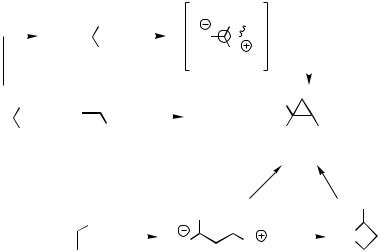
1562 IV |
Pd-CATALYZED REACTIONS INVOLVING CARBOPALLADATION |
|
|||||||||||||||||||||||||||
|
|
|
|
|
|
|
|
|
|
X |
|
|
|
|
|
|
|
|
|
|
X R |
|
|
|
|
||||
|
|
|
|
|
|
|
|
|
|
|
|
|
|
|
|
|
|
|
|
|
|
|
|
||||||
|
|
|
|
|
|
|
M |
|
|
|
|
|
|
|
|
|
|
|
|
|
M |
|
|
|
|
|
|
|
|
|
|
|
|
|
|
|
|
|
|
Y |
|
|
|
|
|
|
|
|
|
|
Y |
|
|
|
|
||||
|
|
|
|
|
|
|
|
|
|
|
|
|
|
|
|
|
|
|
|
|
|
|
|
|
|||||
|
|
|
1 |
|
|
|
|
|
|
|
|
|
|
|
2 |
X |
|
|
|
|
|||||||||
|
|
|
|
|
|
|
|
|
|
|
|
|
|
|
|
|
|
||||||||||||
|
|
|
X |
|
|
|
|
|
|
|
M |
|
|
|
|
|
|
||||||||||||
N2 |
|
|
+ |
|
|
|
|
|
|
|
|
|
|
|
|
|
|
|
|
|
|
|
|
|
|||||
|
|
|
|
|
|
|
|
|
|
|
|
|
|
|
|
|
|
|
|
|
|
|
|
|
|
||||
|
|
|
|
|
|
|
|
R |
|
|
|
|
|
– N2 |
|
|
Y |
|
|
R |
|
||||||||
|
|
|
|
|
|
|
|
|
|
|
|
||||||||||||||||||
|
|
|
Y |
|
|
|
|
|
|
|
|
|
|
||||||||||||||||
3 |
4 |
|
|
|
|
|
|
|
|
|
|
|
|
|
|
|
5 |
|
|
|
|||||||||
|
|
|
|
|
|
|
|
|
|
|
|
|
|
|
|
|
|
|
|
|
|
|
|
– N2 |
– N2 |
|
|||
|
|
|
|
|
|
|
|
|
|
|
|
|
|
|
|
|
|
|
|
|
|
|
|
|
|
|
|||
|
|
|
|
|
|
|
|
|
|
|
|
|
|
|
|
|
|
|
|
|
|
R |
|
|
|
R |
|||
|
|
|
|
|
|
|
|
|
R |
|
|
CH2N2 |
|
– N2 |
|
|
|||||||||||||
|
|
|
|
M |
|
|
|
|
|
|
|
|
M |
||||||||||||||||
|
|
|
|
|
|
|
|
|
|
|
|
|
|
|
|
|
|
M |
|
|
N2 |
|
|
|
|||||
|
|
|
|
|
|
|
|
|
|
|
|
|
|
|
|
|
|
|
|
|
|
|
|
|
|
|
|||
|
|
|
6 |
|
|
|
|
|
|
|
|
|
|
|
|
7 |
|
|
|
|
|
|
8 |
||||||
M = Cu(I), Rh(II), Pd(II)
Scheme 1
The success of palladium catalyzed cyclopropanation reactions is strongly dependent on the substitution pattern of the employed alkene. Electron poor alkenes, most notably, -unsaturated carbonyl compounds and oxygen and nitrogen containing allylic derivatives display good reactivity while electron rich alkenes such as vinyl ethers usually give only low conversion. Terminal and strained alkenes are also good substrates, while the reactivity systematically drops with an increase of its substitution degree.
B. CYCLOPROPANATION OF , -UNSATURATED CARBONYL
COMPOUNDS WITH DIAZOMETHANE
Palladium(II) salts are the catalysts of choice for cyclopropanations with diazomethane, giving especially good results with , -unsaturated aldehydes, ketones, esters or amides., - and , -disubstitution is well tolerated, but trisubstituted alkenes do not react
(Table 1).[5],[7]–[8]
In accordance with this substitution rule, 10, 12, 14 and 16 were cyclopropanated well with diazomethane/Pd(OAc)2, while various trisubstituted steroidal ketones are not suitable substrates (Scheme 2).[7]
Cyclopropyl analogs of prostaglandins have been synthesized starting from , - unsaturated ketone 18a and the corresponding allylic alcohol 18b (Scheme 3). While 19a was obtained in excellent yield (92%, 2:1 mixture of diastereomers), 19b was formed as a mixture of epimers in only 20% yield along with the methyl ether of 18a (20%).[9]
The synthesis of enantiomerically enriched cyclopropanes has been carried out successfully by attaching chiral auxiliaries to , -unsaturated carbonyl compounds. Using Oppolzer’s sultam, a broad range of substituted amides 20 react with diazomethane to 21 in generally good yields and diastereoselectivities (Table 2). Moreover, the products can be easily raised to enantiopurity by recrystallization.[10],[11]
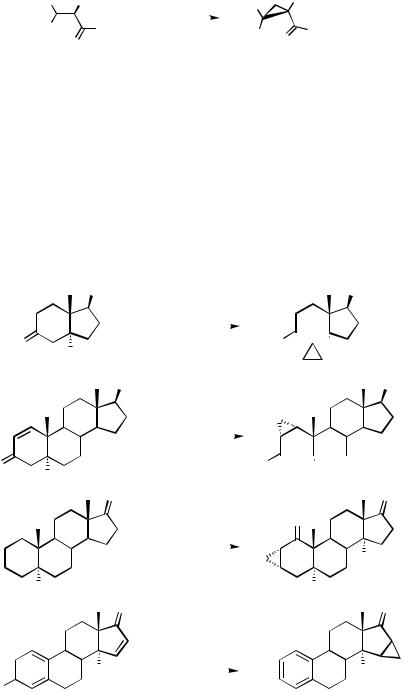
IV.9 CYCLOPROPANATION AND OTHER REACTIONS OF Pd-CARBENE COMPLEXES |
1563 |
TABLE 1. Cyclopropanation of , -unsaturated carbonyl compounds with diazomethane
|
|
R |
1 |
|
|
|
R |
3 |
|
|
R1 |
R3 |
|
|
|
|
|
|
|
|
CH2N2 |
|
|
|
|||
|
|
|
|
|
|
|
|
|
|
|
|
||
|
|
R2 |
|
|
|
R4 |
Pd(OAc)2 |
R2 |
R4 |
|
|||
|
|
|
|
|
|
O |
|
|
|
|
O |
|
|
|
|
|
|
|
|
|
|
|
|
|
|
||
|
|
|
|
|
|
|
|
|
|
|
|
||
R1 |
|
R2 |
|
|
|
R3 |
R4 |
Yield (%) |
Reference |
||||
MeO2C(CH2)3 |
H |
|
|
|
H |
H |
|
80 |
[5] |
||||
Ph |
|
H |
|
|
|
H |
CH3 |
|
85 |
[7] |
|||
Ph |
|
H |
|
|
|
H |
Ph |
|
98 |
[7] |
|||
H |
|
H |
|
|
|
H |
OEt |
|
82 |
[8] |
|||
H |
|
Ph |
|
|
|
H |
OEt |
|
85 |
[7] |
|||
CH3 |
H |
|
|
|
H |
OEt |
|
89 |
[7] |
||||
H |
|
H |
|
|
|
CH3 |
OEt |
|
88 |
[7] |
|||
Ph |
|
H |
|
|
|
H |
OEt |
|
90 |
[7] |
|||
CH |
3 |
CH |
3 |
|
|
H |
CH |
|
n.r.a |
[7] |
|||
|
|
|
|
|
|
|
3 |
|
n.r.a |
|
|||
CH3 |
CH3 |
|
|
H |
OEt |
|
[7] |
||||||
a no reaction.
Ot-Bu
|
|
|
|
|
|
|
|
|
CH2N2 |
|
||
|
O |
|
|
|
|
|
Pd(OAc)2 |
|||||
|
|
H |
|
(no yield reported) |
||||||||
|
|
|
|
|
|
|||||||
|
10 |
|
|
|
|
|
|
|
||||
|
|
|
|
|
|
OAc |
||||||
|
|
|
|
|
|
|
|
|
CH2N2 |
|||
|
|
|
|
|
|
|
|
|
|
|
|
|
|
|
|
|
|
|
|
|
|
Pd(OAc)2 |
|||
O |
|
|
|
|
|
80% |
|
|
|
|||
|
|
H 12 |
|
|
|
|
|
|
|
|||
|
|
|
O |
|||||||||
|
|
|
|
|
|
|||||||
|
O |
|
|
|
|
|
|
|
||||
|
|
|
|
|
|
|
|
|
CH2N2 |
|||
|
|
|
|
|
|
|
|
|||||
|
|
|
|
|
|
|
|
|
|
|
|
|
|
|
|
|
|
|
|
|
|
Pd(OAc)2 |
|||
|
|
|
|
|
|
|
|
|||||
|
|
|
H |
75% |
|
|
|
|||||
|
|
|
|
|
|
|
|
|
|
|||
|
14 |
O |
||||||||||
|
|
|
|
|
|
|||||||
CH3O |
|
|
|
|
|
H |
|
|
CH2N2 |
|||
|
|
|
|
|
|
|
||||||
|
|
|
|
|
|
|
||||||
|
|
|
|
|
|
|
|
Pd(OAc)2 |
||||
|
|
|
|
|
100% |
|
|
|
||||
16
Scheme 2
Ot-Bu
O

H
11
OAc
O


H
13
O
O
H
H
15
O
|
H |
17 |
7:3 exo/endo |
|
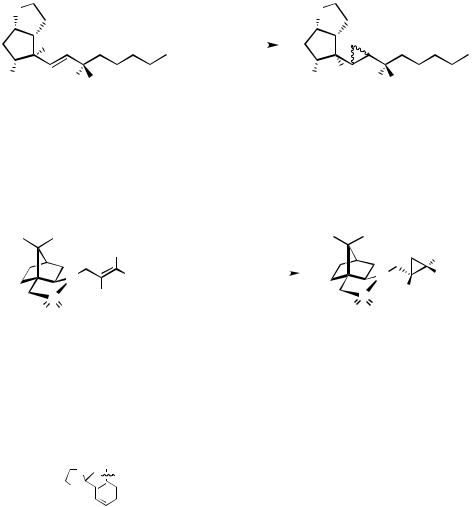
1564 |
IV Pd-CATALYZED REACTIONS INVOLVING CARBOPALLADATION |
|||||
O |
|
|
O |
|
||
|
H |
CH2N2 (excess) |
|
|
|
|
|
cat. Pd(OAc)2 |
|
||||
|
|
|
||||
OPB |
R1 R2 |
|
OPB H |
R1 R2 |
||
|
18a: R1, R2 = O |
|
|
|
19a: R1, R2 = O |
|
|
18b: R1 = OH, R2 = H |
|
|
|
19b: R1 = OH, R2 = H |
|
PB = p-phenylbenzoyl
Scheme 3
TABLE 2. Cyclopropanation of , -unsaturated amides modified by the sultam auxiliary with diazomethane
|
|
O |
R1 |
CH2N2 (excess), 0 °C |
|
|
O |
R1 |
|||||
|
|
|
|
|
|
|
|
||||||
|
N |
|
R2 |
|
|
|
N |
|
|
|
R2 |
||
|
Pd(OAc)2 (0.05 mol %) |
|
|
|
|||||||||
|
|
|
R3 |
|
|
S |
|
|
R3 |
|
|||
S |
|
|
|
|
|
[Ref 10,11] |
|
|
|
||||
O |
O |
|
|
|
O O |
21 |
|
||||||
|
20 |
|
|
|
|
|
|
|
|||||
|
|
|
|
|
|
|
|
|
|
|
|
|
|
R1 |
|
|
R2 |
|
|
R3 |
de (%)a |
de (%)b |
|
|
|
Yield(%) |
|
H |
Ph |
|
|
H |
86 |
|
99 |
|
|
|
73 |
||
H |
2-MeO-Ph |
H |
92 |
|
99 |
|
|
|
73 |
||||
H |
3-MeO-Ph |
H |
72 |
|
98 |
|
|
|
63 |
||||
H |
3,4,5-(MeO)3-Ph |
H |
67 |
|
98 |
|
|
|
62 |
||||
H |
4-(CN)-Ph |
H |
60 |
|
96 |
|
|
|
29 |
||||
H |
2-MeO-5-F-Ph |
H |
73 |
|
>99 |
|
|
|
45 |
||||
H |
O |
|
|
H |
63 |
|
99 |
|
|
|
11 |
||
|
|
|
|
|
|
|
|
|
|
|
|||
|
O |
|
|
|
|
|
|
|
|
|
|
||
|
|
|
|
|
|
|
|
|
|
|
|||
H |
2-Thienyl |
|
|
H |
88 |
|
99 |
|
|
|
71 |
||
H |
4-Br-2-thienyl |
H |
68 |
|
88 |
|
|
|
59 |
||||
H |
2-Furyl |
|
|
H |
76 |
|
>99 |
|
|
|
67 |
||
H |
Ferrocenyl |
H |
82 |
|
>96 |
|
|
|
76 |
||||
H |
Me |
|
|
H |
91 |
|
>99 |
|
|
|
72 |
||
H |
Decyl |
|
|
H |
83 |
|
>99 |
|
|
|
62 |
||
H |
Prop-l-enyl |
H |
|
|
|
|
|
|
— |
||||
Me |
Me |
|
|
H |
|
|
|
|
|
|
— |
||
H |
Me |
|
|
Me |
|
|
|
|
— |
||||
H |
Cl |
|
|
H |
|
|
|
|
|
|
— |
||
Cl |
H |
|
|
H |
|
|
|
|
|
|
— |
||
CF3 |
Me |
|
|
H |
|
|
|
|
|
|
— |
||
H |
CO2Et |
|
|
H |
|
|
|
|
|
|
— |
||
H |
H |
|
|
H |
|
|
|
|
|
|
— |
||
|
|
|
|
|
|
|
|
|
|
|
|
|
|
acrude mixture.
bafter recrystallization.
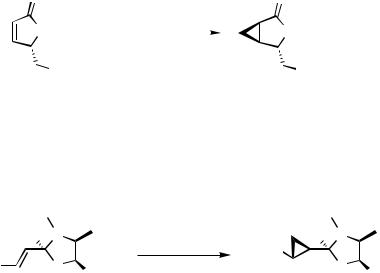
IV.9 CYCLOPROPANATION AND OTHER REACTIONS OF Pd-CARBENE COMPLEXES |
1565 |
Again, only monosubstituted amides can be employed as substrates, while one additional substituent—no matter if electron donating or withdrawing—causes failure of the cyclopropanation. Consequently, the cyclic amide 22 combining the advantages of olefinic strain and , -unsaturated carbonyl compound could be cyclopropanated in excellent yield and good diastereoselectivity (9:1) (Scheme 4).[12],[13]
O |
|
O |
|
NBoc |
CH2N2 |
NBoc |
|
cat. Pd(OAc)2 |
|||
|
|
||
|
100% |
|
|
OSiMe2t-Bu |
|
OSiMe2t-Bu |
|
22 |
|
23 |
|
|
Scheme 4 |
|
The alkene 24 can be cyclopropanated with diazomethane in high yield, offering an attractive way to functionalize , -unsaturated aldehydes diastereoselectively by first forming the N,O-acetales with chiral amino alcohols (Scheme 5).[14]
H |
N |
CH2N2 |
H N |
|
|
R |
|
Ph |
O |
cat. Pd(OAc)2 |
O |
|
Ph |
100% |
Ph |
|
|
|
> 90% de |
|
24 |
|
25 |
Scheme 5
Attempts to carry out carbene transfer reactions with chiral palladium catalysts were unsuccessful so far. Denmark et al. conducted a detailed study[15] in which cyclopropanations of , -unsaturated carbonyl compounds with diazomethane catalyzed by bis- (oxazoline)palladium(II) complexes were investigated. Virtual no asymmetric induction was obtained in these reactions which led to the conclusion —especially in light of the excellent asymmetric environment bis(oxazolines) metal complexes offer in general — that partial or complete ligand dissociation must have been occurred during the course of the reaction.
C. CYCLOPROPANATION OF ALKENYLBORONIC ESTERS
Alkenylboronic esters proved to be good substrates for the palladium catalyzed cyclopropanation by diazomethane (Table 3).[16],[17] Since the substrates can be obtained by hydroboration of alkynes and the resulting cyclopropylboronic ester can be further modified, this strategy offers an especially versatile entry to functionalized cyclopropanes. Besides oxidation to cyclopropanols, functionalization in Suzuki coupling reactions are possible as discussed in Sect. III.2.2.
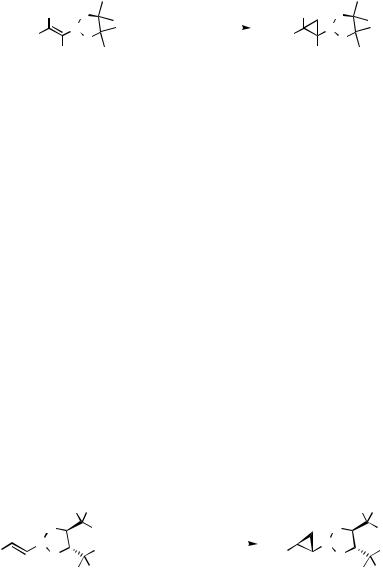
1566 |
IV Pd-CATALYZED REACTIONS INVOLVING CARBOPALLADATION |
TABLE 3. Cyclopropanation of vinyl boranes with dizomethane |
|
R2 O |
|
Pd(OAc)2 (5 mol %) |
|
|
|
R2 O |
|
|
B |
|
|
|
|
B |
|
R1 |
|
0 °C, CH2N2/Et2O |
|
|
R1 |
||
O |
|
|
|
O |
|||
|
R3 |
|
|
|
|
|
R3 |
|
|
|
|
|
|
|
|
R1 |
|
R2 |
|
R3 |
|
Yield (%) |
|
H |
|
H |
|
H |
|
92 |
|
n-Bu |
|
H |
|
H |
|
88 |
|
H |
|
n-Bu |
|
H |
|
67 |
|
Cl(CH2)3 |
|
H |
|
H |
|
90 |
|
H |
|
H |
CH3 |
|
72 |
||
CH3OCO |
|
H |
|
H |
|
63 |
|
PhSCH2 |
|
H |
|
H |
|
62 |
|
Me3Si |
|
H |
|
H |
|
83 |
|
CH3 |
|
CH3 |
|
H |
|
0 a |
|
CH3 |
|
H |
CH3 |
|
0 b |
||
PhS |
|
H |
|
H |
|
0 c |
|
aStarting material was recovered unchanged.
b40/60 mixture of starting material and product.
conly unidentified products were obtained which obtained neither the starting material nor the product.
Moreover, alkenylboronic esters can be modified by chiral auxiliaries,[18]–[20] and especially the TADDOL auxiliary has been demonstrated to be an effective chiral inductor for the cyclopropanation reactions discussed here (Table 4).[19],[20] In order to keep the catalyst concentration low its pretreatment by ultrasonication to guarantee a fine distribution was found to be advantageous.
TABLE 4. Cyclopropanation of vinyl boranes modified with the TADDOL auxiliary with diazomethane
|
|
Ph |
Ph |
|
|
Ph |
Ph |
||
|
|
O |
OMe |
Pd(OAc)2 (5 mol %) |
|
O |
OMe |
||
|
B |
OMe |
|
B |
OMe |
||||
R |
0 °C, CH2N2/Et2O |
R |
|||||||
|
O |
O |
|||||||
|
|
|
|||||||
|
|
Ph |
Ph |
|
|
Ph |
Ph |
||
|
|
|
|
|
|
|
|
|
|
|
|
R |
|
de (%) |
|
Yield (%) |
|
||
|
|
|
|
|
|
|
|
||
|
|
n-Bu |
78 |
|
98 |
|
|
||
|
|
t-Bu |
74 |
|
95 |
|
|
||
|
|
n-Pentyl |
86 |
|
99 |
|
|
||
|
|
TPSO(CH2)3 |
90 |
|
89 |
|
|
||
|
|
Ph |
|
72 |
|
93 |
|
|
|
|
|
TBSOCH2 |
40 |
|
90 |
|
|
||
|
|
HOCH2 |
60 |
|
98 |
|
|
||

IV.9 CYCLOPROPANATION AND OTHER REACTIONS OF Pd-CARBENE COMPLEXES |
1567 |
D. CYCLOPROPANATION OF NON FUNCTIONALIZED ALKENES
Non functionalized alkenes undergo cyclopropanation with diazomethane/Pd(II) if they are strained[21]–[23] or terminal substituted.[24] Consequently, carbene transfer to alkenyl substituted cyclohexenes occurs highly regioselective,[24] contrasting the reactivity of such derivatives towards cyclopropanation using diiodomethane/zinc or metal carbenoids (Table 5).
TABLE 5. Cyclopropanation of unfunctionalized alkenes with diazomethane
|
R2 |
|
|
CH2N2/Pd(OAc)2 |
R2 |
|
|
|
|
|
|
||
|
R1 |
|
|
|
R1 |
|
|
Alkene |
|
|
Product |
Yield (%) |
Reference |
|
|
|
|
|
|
|
n-Oct |
n-Oct |
89 |
[24] |
|||
|
|
|||||
|
CO2Et |
|
|
CO2Et |
90 |
[22] |
|
|
|
|
|
77 |
[24] |
|
|
|
|
|
82 |
[24] |
|
|
|
|
|
||
63 |
[24] |
91a |
[23] |
93a |
[23] |
67 [21]
(Continued )
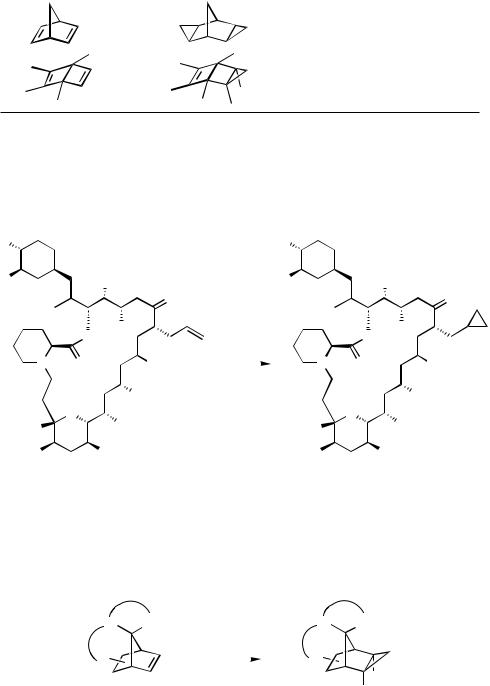
1568 |
IV |
Pd-CATALYZED REACTIONS INVOLVING CARBOPALLADATION |
|
|
TABLE 5. (Continued ) |
|
|
||
|
|
|
|
|
|
Alkene |
Product |
Yield (%) |
Reference |
|
|
|
|
|
|
|
|
63 |
[21] |
|
|
|
89 |
[21] |
a mixture of diastereomers.
Accordingly, the regioselective cyclopropanation of FK506 can be understood despite of the two other C—C double bonds present and, most notably, the carbonyl function at C-9 which reacts with diazomethane in the absence of palladium(II) acetate to the corresponding oxirane (Scheme 6).[25]
HO |
|
|
|
|
|
|
|
|
HO |
|
|
|
|
|
|
|||||
MeO |
|
|
Me |
|
|
|
MeO |
|
|
|
|
Me |
||||||||
|
|
|
|
|
|
|
|
|
||||||||||||
|
|
|
|
|
|
|
|
O |
|
|
|
|
|
|
|
|
|
|
|
O |
|
|
|
|
|
|
|
|
|
|
|
|
|
|
|
|
|
|
|||
|
|
|
|
|
OH |
|
|
|
|
|
|
|
|
|
|
|
OH |
|||
|
|
|
|
|
O |
|
|
|
CH2N2 |
|
|
|
|
|
|
|
|
O |
|
|
|
|
|
|
|
|
|
|
|
|
|
|
|||||||||
|
|
|
|
|
|
|
|
|
|
|
|
|
|
|
|
|
|
|
||
|
N |
|
|
O |
Me |
|
N |
|
|
|
O |
|
Me |
|||||||
|
|
|
Pd(OAc)2 |
|
|
|
|
|
||||||||||||
|
|
|
|
|
O |
|
|
|
|
|
|
|
|
O |
|
|
||||
|
|
|
|
|
|
87% |
|
|
|
|
|
|
|
|
|
|
||||
|
|
|
|
|
|
|
|
|
|
|
|
|
||||||||
O |
|
|
9 |
|
Me |
|
[Ref 25] |
O |
|
|
|
9 |
|
|
Me |
|||||
|
|
|
O |
|
|
|
|
|
O |
|
|
|||||||||
|
|
|
|
|
|
|
||||||||||||||
|
|
|
|
|
|
|
|
|
|
|
|
|
|
|
||||||
HO |
|
|
OMe |
|
|
|
HO |
|
|
|
|
OMe |
||||||||
|
|
|
|
|
|
|
|
|
|
|
|
|
|
|||||||
Me |
|
|
OMe |
FK506 |
|
|
Me |
|
|
|
|
OMe |
||||||||
|
|
|
|
|
|
|
|
|
Scheme 6 |
|
|
|
|
|
|
|
|
|
|
|
A very large number of norbornene derivatives has been cyclopropanated in good yields giving the exo distereomer in all cases (Scheme 7).[5],[6],[21],[23],[26]–[29]
Besides strained cyclopentenes, cyclobutenes such as dewar benezene derivatives (see Table 5) also undergo cyclopropanation with respectable yields. In contrast, cyclopropenes react with diazomethane in a complex manner to form mixtures of monomeric
R2 |
R3 |
R2 |
R3 |
|
R1 |
|
CH2N2 |
R1 |
|
|
Pd(OAc)2 |
H |
||
|
|
|
||
|
|
62–100% |
|
|
H
Scheme 7
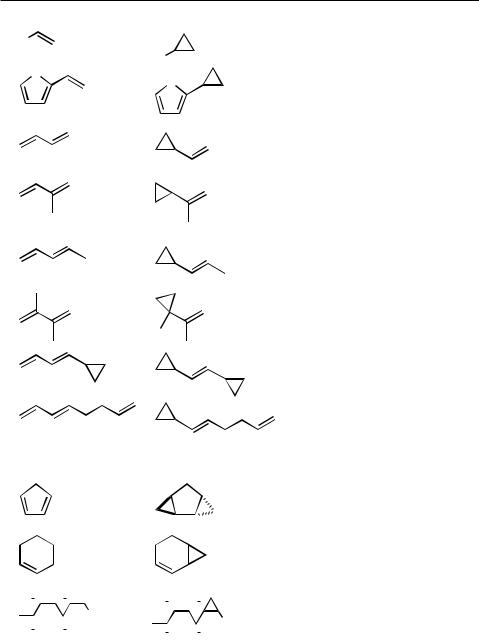
IV.9 CYCLOPROPANATION AND OTHER REACTIONS OF Pd-CARBENE COMPLEXES |
1569 |
products as a result of ring opening and insertion accompanied by considerable amounts of oligomeric products.[5]
Interesting results are obtained for the cyclopropanation of conjugated dienes and polyenes (Table 6). Not surprisingly, aryl substituted alkenes react selectively at the olefinic double bond, but also in non aromatic polyenes differentiation of the double
TABLE 6. Cyclopropanation of polyenes with diazomethane
Alkene |
Product |
Yield (%) |
Comment |
Reference |
|||||||||
|
|
|
|
|
|
|
|
||||||
Ph |
|
|
|
|
90 |
|
[30] |
||||||
|
|
|
|
|
|
|
Ph |
|
|
|
|||
|
S |
|
S |
|
|
|
|||||||
|
|
|
|
|
|
|
|
98 |
|
[5] |
|||
|
|
|
|
|
|
|
|
|
|
|
|
||
|
|
|
|
|
|
|
|
|
|
|
67 |
along with 29% of |
[26] |
|
|
|
|
|
|
|
|
|
|
|
|
biscyclopropyl |
|
|
|
|
|
|
|
|
|
|
|
|
|
product |
|
|
|
|
|
|
|
|
|
|
|
|
70 |
along with 12% of |
[26] |
|
|
|
|
|
|
|
|
|
|
|
|
regioisomer and 9% |
|
|
|
|
|
|
|
|
|
|
|
|
|
of biscyclopropyl |
|
|
|
|
|
|
|
|
|
|
|
|
|
product |
|
|
|
|
|
|
|
|
|
|
|
|
90 |
|
[6] |
|
|
|
|
|
|
|
|
|
|
|
65 |
along with 15% of |
[26] |
|
|
|
|
|
|
|
|
|
|
|
|
biscyclopropyl |
|
|
|
|
|
|
|
|
|
|
|
|
|
product |
|
|
|
|
|
|
|
|
|
|
|
|
91 |
|
[6] |
|
|
|
|
|
|
|
|
|
|
|
49 |
along with 6% of |
[6] |
|
|
|
|
|
|
|
|
|
|
|
|
terminal regioisomer |
|
|
|
|
|
|
|
|
|
|
|
|
|
and 8% of α,ω- |
|
|
|
|
|
|
|
|
|
|
|
|
|
biscyclopropyl |
|
|
|
|
|
|
|
|
|
|
|
|
|
product |
|
|
|
|
|
|
|
|
|
|
|
|
75 |
along with 15% of |
[26] |
|
|
|
|
|
|
|
|
|
|
|
|
monocyclopropyl |
|
|
|
|
|
|
|
|
|
|
|
|
|
product |
|
|
|
|
|
|
|
|
|
|
|
|
53 |
along with 13% of |
[26] |
|
|
|
|
|
|
|
|
|
|
|
|||
|
|
|
|
|
|
|
|
|
|
|
|
biscyclopropyl |
|
|
|
|
|
|
|
|
|
|
|
|
|
|
|
|
|
|
|
|
|
|
|
|
|
|
|
product |
|
|
|
|
|
|
|
|
(CH2)3CO2Et |
|
|
|
90 |
|
[5] |
|
|
|
|
|
|
|
|
|
|
|
|||
|
|
|
|
|
|
|
|
|
|
|
|||
|
|
|
|
|
|
|
|
|
|
|
|||
|
|
|
|
|
2 |
|
(CH2)3CO2Et |
|
|
||||
|
|
|
|
|
|
|
|
||||||
|
|
|
|
|
|
|
|
|
|
|
2 |
|
|
|
|
|
|
|
|
|
|
|
|
|
|
|
|
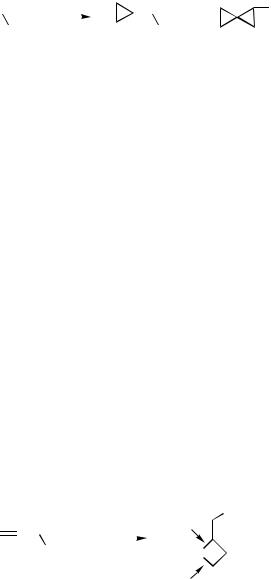
1570 |
IV Pd-CATALYZED REACTIONS INVOLVING CARBOPALLADATION |
TABLE 7. Cyclopropanation of allenes with diazomethane |
|
|
|
• |
|
|
CH2N2 |
|
|
|
R |
|
|
|
|
|
|
|
|||
|
|
|
|
|
|
|
|
+ |
|
|
|
|
|
R |
Pd(OAc)2 |
|
|
R |
|
|
|
|
|
|
|
|
|||
26 |
|
|
27 |
|
28 |
||||
|
|
|
|
|
|
|
|
|
|
|
R |
|
Yield of 27 (%) |
Yield of 28 (%) |
|||||
|
|
|
|
|
|
|
|
|
|
|
Bu |
|
67 |
|
|
25 |
|||
CH2CH2OH |
|
2 |
|
|
60 |
||||
CH2CH2OAc |
|
34 |
|
|
56 |
||||
CH2CH2OTs |
|
78 |
|
|
— |
||||
CH2CH2Br |
|
63 |
|
|
27 |
||||
|
Ph |
|
49 |
|
|
— |
|||
|
|
|
|
|
|
|
|
|
|
bonds has been successful. For a number of 1,3-butadienes it was demonstrated that monocyclopropanation preferentially takes place at the sterically less hindered double bond. A terminal conjugated double bond is more reactive than a non conjugated one. Although in many cases regioisomers or biscyclopropanated products are obtained, some impressive cases of regioselective cyclopropanations of dienes or even trienes have been reported (Table 6). However, 1,3,5-cyclohexatriene and 1,3,5,7-cycloocattetraene failed to give cyclopropanation at all.[5]
Allenes are also successfully cyclopropanated if a large excess of diazomethane is employed, which preferentially takes place at the less substituted double bond. Nevertheless, the bisadducts are formed in many cases as well (Table 7).[31]
However, in these reactions complex mixtures of unusual side products resulting from an oligomethylenation have been also isolated. The products can be explained by invoking intermediates like 29, which undergo methylene insertion into the metal carbon bond (Scheme 8).[32]
Ph
• |
|
|
|
CH2N2 |
CH2 |
|
|
|
|
|
|
||
|
|
|
|
|
||
|
|
|
R |
Pd(OAc)2 |
Pd |
|
|
|
|
|
|||
|
|
|
|
|
CH2 |
|
26 |
|
|
|
29 |
||
Scheme 8
E. CYCLOPROPANATION OF ALLYLOXY AND RELATED COMPOUNDS
Allyloxy[33],[34] and allylamino[12],[33]–[35] are also good substrates for the title reaction. While mostly terminal alkenes have been used, internal alkenes are activated sufficiently in such cases to undergo cyclopropanation (Table 8).
